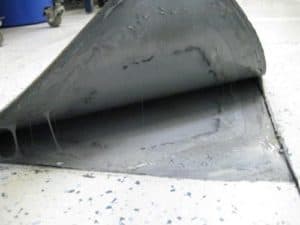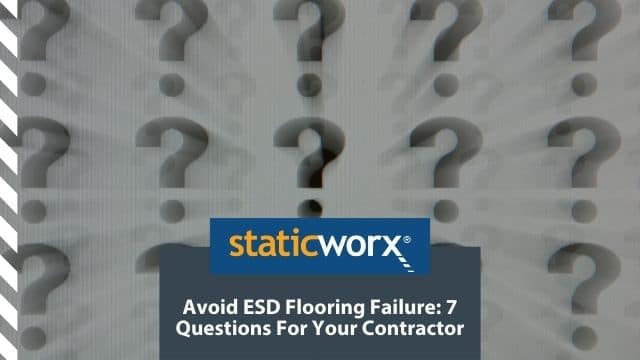Protecting ESD Floors from Moisture
Note: Vapor problems are preventable with integrally applied pH resistant adhesive.
Information and Helpful Links to Protect ESD Flooring from Moisture
Concrete Moisture Problems
Static control floors should never be installed without first testing your concrete slab for possible moisture and alkalinity problems. Up front testing can prevent future problems and shutdowns due to failed flooring installations.

Did you know that the number one cause of ESD flooring installation failures is moisture permeation through concrete slabs from below the sub-floor? Moisture vapor – inside concrete – becomes alkaline, adversely reacting with flooring adhesives and consequently compromising the bond you expect from adhesives. More importantly, this problem is almost always unexpected because it rarely involves ground water, heavy rains or the local water table – so there are no visual predictors.
The problem isn’t solved by installing drains or water diverters around a building because it isn’t the result of weather. It is the result of evaporation of water from far below the surface.
The worst problems are where you would expect them the least: desert and arid climates like California, Arizona, Colorado, Utah, Texas and Nevada. But the problem also haunts many other locations, so it’s always a necessity to learn about moisture and how to test for it before it ruins your new ESD flooring installation.
And, if you’re a flooring professional, you’re expected to know about moisture problems because your client certainly doesn’t know about it.
Static control floors should never be installed without first testing your concrete slab for possible moisture and alkalinity problems. Up front testing can prevent future problems and shutdowns due to failed flooring installations.

Did you know that the number one cause of ESD flooring installation failures is moisture permeation through concrete slabs from below the sub-floor? Moisture vapor – inside concrete – becomes alkaline, adversely reacting with flooring adhesives and consequently compromising the bond you expect from adhesives. More importantly, this problem is almost always unexpected because it rarely involves ground water, heavy rains or the local water table – so there are no visual predictors.
The problem isn’t solved by installing drains or water diverters around a building because it isn’t the result of weather. It is the result of evaporation of water from far below the surface.
The worst problems are where you would expect them the least: desert and arid climates like California, Arizona, Colorado, Utah, Texas and Nevada. But the problem also haunts many other locations, so it’s always a necessity to learn about moisture and how to test for it before it ruins your new ESD flooring installation.
And, if you’re a flooring professional, you’re expected to know about moisture problems because your client certainly doesn’t know about it.
Are you looking for a floor you can install, despite moisture vapor issues, without installing a moisture barrier?
StaticWorx GroundLock Extreme interlocking vinyl tile can be installed over any subfloor including concrete slabs with vapor issues. Ask your StaticWorx Technical Rep if GroundLock Extreme could be a solution for your moisture problem.
Call: 617-923-2000. Email: [email protected]
Below are helpful links to help you learn more about hydrostatic pressure, osmotic blisters, vapor emissions and moisture vapor problems installing Resilient and Epoxy Flooring:
Articles: Floor Moisture Test Methods and Floor Moisture Problems
Current Articles
When 3 Pounds is Not 3 Pounds
by Peter Craig and George Donnelly
Vapor Barriers: Nuisance or Necessity?
By: Peter Craig
Moisture Mitigation for Concrete Slabs
by Peter Craig
5 Tips for Easy and Effective ASTM F-2170 Testing
by Tom Laurenzi
10 Guidelines for ASTM F2170 Compliance
by Jason Spangler
Older Articles
The information in these articles may no longer be current and links are provided for reference only.
Avoiding Flooring Failure— Insist on Moisture Testing
by Terry Nali, Coordinator
INSTALL Twin Cities and IFMA MSP Member
Reducing Bond Failures Caused by Moisture Vapor Transmission
By: Robert R. Cain
Vapor Barriers under Concrete Floor Slabs: Friend or Foe?
by Steve Ragan
Calcium Chloride v. In-situ Relative Humidity
Which moisture test method is better? Here’s what one moisture expert has to say.
Testing for Moisture
Designation: F1869 – 16a
Standard Test Method for Measuring Moisture Vapor Emission Rate of Concrete Subfloor Using Anhydrous Calcium Chloride
Designation: F2170 – 19a
Standard Test Method for Determining Relative Humidity in Concrete Floor Slabs Using in situ Probes
Current Articles
When 3 Pounds is Not 3 Pounds
by Peter Craig and George Donnelly
Vapor Barriers: Nuisance or Necessity?
By: Peter Craig
Moisture Mitigation for Concrete Slabs
by Peter Craig
5 Tips for Easy and Effective ASTM F-2170 Testing
by Tom Laurenzi
10 Guidelines for ASTM F2170 Compliance
by Jason Spangler
Testing for Moisture
Designation: F1869 – 16a
Standard Test Method for Measuring Moisture Vapor Emission Rate of Concrete Subfloor Using Anhydrous Calcium Chloride
Designation: F2170 – 19a
Standard Test Method for Determining Relative Humidity in Concrete Floor Slabs Using in situ Probes
Older Articles
The information in these articles may no longer be current and links are provided for reference only.
Avoiding Flooring Failure— Insist on Moisture Testing
by Terry Nali, Coordinator
INSTALL Twin Cities and IFMA MSP Member
Reducing Bond Failures Caused by Moisture Vapor Transmission
By: Robert R. Cain
Vapor Barriers under Concrete Floor Slabs: Friend or Foe?
by Steve Ragan
Calcium Chloride v. In-situ Relative Humidity
Which moisture test method is better? Here’s what one moisture expert has to say.
American Society for Testing and Materials (ASTM)
ASTM F2170-03
Standard Test Method for Determining Relative Humidity in Concrete Floor Slabs Using in situ Probes
Link to purchase ASTM Standard F2170
ASTM F1869 – 04
Standard Test Method for Measuring Moisture Vapor Emission Rate of Concrete Subfloor Using Anhydrous Calcium Chloride
Link to purchase ASTM Standard F1869
Historical Standard ASTM E1907 – 04
Standard Guide to Methods of Evaluating Moisture Conditions of Concrete Floors to Receive Resilient Floor Coverings
Link to purchase ASTME 1907 – 04
This guide includes both quantitative and qualitative procedures used to determine the amount of water or water vapor present in or emitting from concrete slabs and criteria for evaluating the moisture-related acceptability of concrete slabs to receive resilient floor coverings and related adhesives.
ASTM D4263 – 83(2005)
Standard Test Method for Indicating Moisture in Concrete by the Plastic Sheet Method
Link to purchase ASTM Standard D4263-83(2005)
Other Useful Media from StaticWorx




Get in Touch
The form below will help us better understand your needs and get you as quickly as possible to the right person. We look forward to helping you solve your static problem!
You can expect a response within 24 hours. For faster service, please give us a call: 617-923-2000
"*" indicates required fields
Visit our privacy policy to find out how we process data.

StaticWorx high-performance static-control floors protect electronic components, explosives, and high-speed computers from damage caused by static electricity. ESD flooring is part of a system. Choices should always be based on objective, researched evidence. When you partner with us, we look at all possible items that may need to integrate with the floor, and, focusing on your goals and objectives, help you find the right floor for your application.








